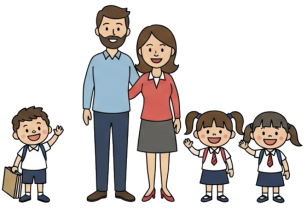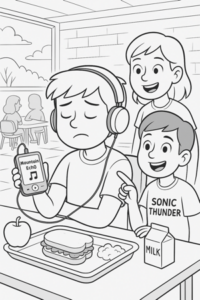
Question More, Action Knowledge.
Remember, at QMAK, we don’t just teach; we empower. We don’t just inform; we inspire. We don’t just question; we act. Become a Gold Member, and let’s unlock your child’s full potential, one question at a time.
Here you will find the resources that compliment the lessons taught during the month.
Songs are a great way to reinforce lessons in a fun, memorable way—by engaging musical and auditory learning styles, they help key ideas stick in children’s minds and support long-term retention well beyond the lesson.
Verse 1:
Watching all the crowds roll by
Everyone seems to know why
That new thing’s the place to be
But what’s the truth you really see?
Pre-Chorus:
Social proof and FOMO’s call
Echo chambers down the hall
But beneath the trending stream
Lies a deeper truth to glean
Chorus:
Lead Your Own Parade, find your way
Question why the crowds sway
Not every wagon’s meant for you
Lead Your Own Parade, make it true
Verse 2:
Viral dances, trending songs
Following where we belong?
Take a breath and ask your heart
If this bandwagon’s really smart
(Pre-Chorus)
(Chorus)
Bridge:
Between the likes and shares and views
Lives a choice that you must choose
Popular’s not always right
Your authentic path shines bright
(Chorus)
Outro:
Lead Your Own Parade, now you know
Sometimes it’s braver not to go
Having your child complete this coloring page right after reading the story helps transition the lesson from imaginative reading to creative expression, turning their thoughts into a vibrant work of art.
Color-In Picture

Movies are a great tool for engaging visual and auditory learners, and when paired with comprehension quizzes, they encourage active viewing—helping children process and retain key concepts rather than just being passively entertained.
A Bug’s Life offers a delightful exploration of the bandwagon effect through its story of an ant colony learning to stand up against grasshopper oppression.
Through Flik’s journey to transform his colony from passive acceptance to collective resistance, students witness how group behavior can shift dramatically once a few individuals demonstrate the courage to challenge the status quo.
The film demonstrates the bandwagon effect as the ants progress from fearful compliance with the grasshoppers’ demands to joining together in resistance, showing how seeing others take action can inspire widespread participation in change.
As viewers follow the colony’s evolution from accepting their role as victims to realizing their collective power, they learn how the bandwagon effect can work in both directions – either reinforcing oppressive systems or catalyzing positive transformation.
Through its clever allegory about standing up to bullies, the film shows young viewers how group momentum can transform from a force for compliance into a powerful tool for positive change once someone takes the first brave step.
1. How does the ant colony’s initial acceptance of the grasshoppers demonstrate the bandwagon effect?
a) Each ant independently chose to comply
b) The ants followed the collective behavior of submission
c) The grasshoppers were actually helpful
d) The ants enjoyed giving away food
2. What role does Flik play in reversing the negative bandwagon effect?
a) He shows others that resistance is possible
b) He follows the crowd
c) He accepts the status quo
d) He avoids confrontation
3. How do the circus bugs initially affect the colony’s bandwagon behavior?
a) They make things worse
b) They have no effect
c) They immediately solve all problems
d) They inspire the ants to believe change is possible
4. When the ants begin to resist together, what aspect of the bandwagon effect is shown?
a) Fear of missing out
b) Collective courage building as more join in
c) Individual decision making
d) Random behavior
5. How does Princess Atta’s changing attitude influence the colony?
a) It has no effect
b) It discourages resistance
c) It demonstrates leadership following
d) Her support helps others join the resistance
6. What role does Hopper’s fear of ant rebellion demonstrate about the bandwagon effect?
a) He knows collective action can overturn power structures
b) He enjoys the ants’ cooperation
c) He doesn’t care about group behavior
d) He supports ant independence
7. How do the young ants’ reactions show the bandwagon effect?
a) They ignore all changes
b) They resist new ideas
c) They quickly adopt new behaviors they see
d) They act completely independently
8. The bird-building project demonstrates what aspect of the bandwagon effect?
a) Individual work is better
b) Group projects always fail
c) Leadership doesn’t matter
d) Collective participation grows with visible progress
9. How does Dot’s bravery influence other young ants?
a) It has no impact
b) They become more fearful
c) They ignore her
d) They feel inspired to show courage too
10. What does the film’s conclusion teach about the bandwagon effect?
a) Group behavior never changes
b) Positive change can spread through collective action
c) Individual actions don’t matter
d) Fear always wins
1. b
2. a
3. d
4. b
5. d
6. a
7. c
8. d
9. d
10. b
This beautifully illustrated story follows the journey of a quiet and often overlooked boy named Brian, who feels invisible in his classroom.
When a new student named Justin arrives, Brian extends a small act of kindness that sets in motion a chain of events that helps him find connection, confidence, and a sense of belonging.
1. Who is the main character of the story?
a) Justin
b) Brian
c) Emilio
d) Madison
2. Why is Brian described as “invisible”?
a) He can turn invisible at will
b) He wears camouflage clothes
c) He’s often overlooked and left out by others
d) He’s a ghost
3. What does Brian love to do?
a) Play sports
b) Sing loudly
c) Draw and use his imagination
d) Tell jokes
4. What happens when the teacher asks the class to get into groups?
a) Brian is the first one chosen
b) Brian is left out
c) Brian forms his own group
d) Brian goes home
5. Who is the new student that joins Brian’s class?
a) Justin
b) Emilio
c) Madison
d) Sarah
6. How does Brian first interact with the new student?
a) He ignores him
b) He leaves him a welcome note with a drawing
c) He shows him around the school
d) He invites him to play at recess
7. What special talent does the new student share with the class?
a) Juggling
b) Singing
c) Dancing
d) Cooking
8. How does Brian help the new student during the class project?
a) He does all the work for him
b) He offers ideas for their project
c) He asks the teacher to change groups
d) He doesn’t help at all
9. What change do we see in Brian by the end of the story?
a) He becomes actually invisible
b) He transfers to a new school
c) He starts to become more visible as he’s included
d) He decides he prefers being alone
10. What is the main message of the book?
a) It’s better to be invisible
b) One small act of kindness can make a big difference
c) New students should always be left alone
d) Drawing is the most important skill
1. b) Brian
2. c) He’s often overlooked and left out by others
3. c) Draw and use his imagination
4. b) Brian is left out
5. a) Justin
6. b) He leaves him a welcome note with a drawing
7. d) Cooking
8. b) He offers ideas for their project
9. c) He starts to become more visible as he’s included
10. b) One small act of kindness can make a big difference
Setting “The Compassion Quest” to music creates a gentle way for children to practice empathy, transforming the concept that everyone is doing their best into a catchy tune they can easily remember. The song’s warm refrain of “Everybody’s trying their best” gives children a simple perspective shift they can apply when facing conflicts or misunderstandings. This melodic approach makes compassion feel like an exciting adventure rather than a difficult practice, providing children with a friendly tune they can recall whenever they feel frustrated with themselves or others, helping them develop kindness and understanding through the natural connection that music creates.
Verse 1:
Imagine a world where everyone tries
To do what they can with all they comprise
Your friends and your family, strangers too
All doing their best, just like you
Pre-Chorus:
It’s not always easy to see
But kindness is the key
Chorus:
Everybody’s trying their best
Put your heart to the test
With patience and love, we’ll go far
Compassion’s our guiding star
Verse 2:
When you make a mistake, don’t be too hard
Remember you’re doing your best, even when it’s hard
Look at others with gentler eyes
Their struggles and efforts, you’ll recognize
(Pre-Chorus)
(Chorus)
Bridge:
In this quest for understanding
We’re all just souls expanding
With empathy as our guide
We’ll stand right by each other’s side
(Chorus)
Outro:
Open your heart, what do you see?
A world full of possibility
Where everyone, including you
Is doing the best they can do

Remember, at QMAK, we don’t just teach; we empower. We don’t just inform; we inspire. We don’t just question; we act. Become a Gold Member, and let’s unlock your child’s full potential, one question at a time.